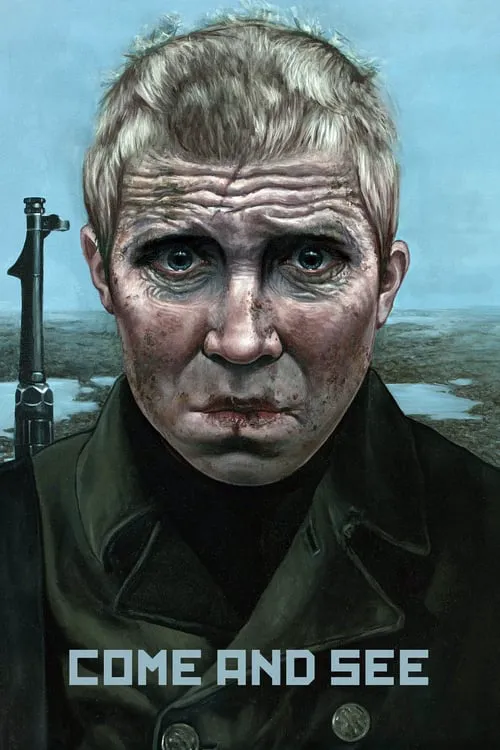Come and See

Plot
In the picturesque yet turbulent region of Byelorussia during World War II, 12-year-old Florya lives in a small village surrounded by lush forests and rolling hills. A tranquil existence for a young boy, that is soon shattered by the all-pervasive terror of the war. Florya's idyllic days are forever changed when his family decides he should join the weary Resistance fighters in the forest. While Florya is initially bound by filial duty, he doesn't see the value in risking his young life in a brutal war. It's only after witnessing the systematic destruction of his village at the hands of the relentless German forces that Florya scours the woods in search of safety. On his journey, Florya stumbles upon a fellow survivor named Glasha, a young girl with no age-defined innocence, witnessing the atrocities firsthand. The girl's perspective sharpens Florya's, reinforcing her resolve to join the desperate fight against the invaders. Both travel in tow, with uncertainty guiding their steps, through a landscape laid to ruin. The couple's journey leaves enduring impressions, raising questions about the fragility of human existence amidst conflict and despair. Thus, the village of Florya symbolizes hope and youthfulness before the war; afterward, however, a shattered life leaves in its wake. Florya returns to his village at the stern insistence of his worried family, not knowing what fate awaits his home town. Before he arrives, his town has fallen. The heart-wrenching moment where Florya stumbles upon his village devastates the young boy. Expectation yields to reality: utter destruction everywhere that was once so sacred in his eyes. All that remains is deathly silence. That crucial decision, one which led his life down the harsh path of survival and pain, is where the true essence begins. The scene transitions into the isolation and terror which drives many onto the path of destruction, their state becoming detached from all they once knew. An arduous journey that tests the resilience and resolve of our young protagonists: those acts which challenge all expectations shatter them completely. For months, Florya struggles to grasp reality. As if numb, it takes him time to acknowledge and understand the despair that grips him under a relentless weight of an almost hopeless existence. Hunger, fear and the perpetual awareness of loss push him to cross unsavory lines. Florya faces intense hardships as day turns into night and hope for justice wavers through desperate times. Solace lies in holding on to Glasha, clinging on tightly as a drowning man clings to a plank. Fending for themselves against a backdrop devoid of comfort is all he knows. A series of brutal, unforgettable experiences tests the strength that remains within him. War sears an indelible mark into Florya's fragile psyche – leaving unbreakable cracks that can never be fixed. Throughout these trials, the frail child inside Florya still resists destruction at every step. With a resilience that cannot be weakened, he weathers each blow, convinced that his fragile soul must survive this harsh, inhumane cycle. It would seem fate hasn't relented to offer an easy escape, sending its all out against this child. Life becomes increasingly perilous for Florya - to save himself, he must harden in the face of it. Even innocence is tainted in this realm, forcing its subjects to sacrifice cherished heart and soul to defy destruction. Glasha's presence becomes his guiding light in dark and shattering moments – for himself and for her.
Reviews
Waylon
A poem of death, an apocalyptic vision, shrapnel blooms searing through the heart. Nazi demons leave no remains, yet spring returns in dreams. This is hell, come and see for yourself.
Jude
The most brutal film in cinematic history—just watch it. It's a pity I've never appreciated filmmakers who inject their own emotions into a film. But setting aside the political and ideological elements, the portrayal of humanity during wartime remains deeply affecting. ★★★★
August
Not just an underrated gem, but an underrated masterpiece. The sound and visuals, which communicate the suffering soul and dark history, blur the lines between expressionism and realism. The overwhelming and powerful audiovisual experience completely drags the viewer into another space-time that once truly existed. All the words that describe the cruelty of war pale in comparison and become mere embellishments. It's been a very, very long time since I've seen a movie that made me feel so insignificant after the credits rolled. → 20.12.4 Revisited at the film archive after three years. A confirmation. Let go of superficial authority.
Taylor
A lot of people walked out midway through the film, some fell asleep, their snores echoing through the theater. After the credits rolled, a girl who had been glued to her phone in the front half of the rows finally looked up, declaring the film "misery porn" before laughing with her friend. In that moment, I felt that people are indeed too well-fed these days, shouldn't there be some basic empathy and respect as a human being? No piece of history deserves to be evaluated like that. Admittedly, the film has pacing issues, and the viewing experience can be quite disturbing, but even if it is "exploitative," I believe the director, the crew, and even the people in that entire period of WWII history, didn't expect you to cheapen their experiences with the cost of a movie ticket...
Alice
The ideological inflexibility is too obvious. The so-called "most brutal truth of war" is actually filled with subjective, "gritted-teeth hatred," leading to a complete loss of control in the end. It's acceptable as propaganda, but its artistic presentation and aesthetic qualities relegate it to second-rate status.
Recommendations




